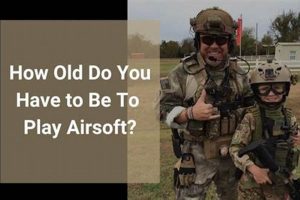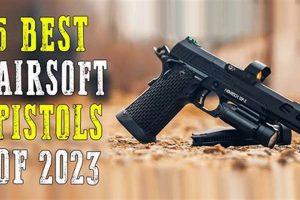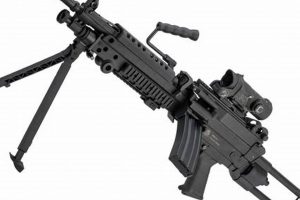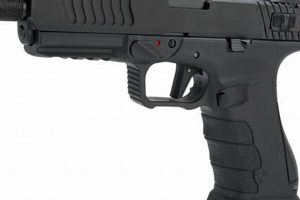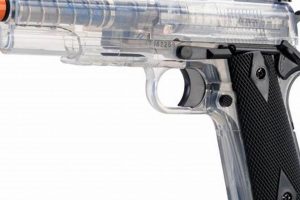An airsoft full auto pistol is a type of replica firearm designed to fire plastic projectiles at a rapid, continuous rate. These devices mimic the appearance and, to some extent, the function of real-world automatic handguns, but are intended for recreational use in simulated combat scenarios. They utilize various power sources, such as compressed gas or electric motors, to propel the projectiles. A typical example would be a gas blowback model replicating a popular service pistol, capable of expelling BBs continuously as long as the trigger is depressed and ammunition is available.
The proliferation of these devices stems from their capacity to provide a heightened sense of realism and tactical advantage within airsoft gameplay. The rapid firing rate offered enhances suppressive fire capabilities and close-quarters combat effectiveness. Historically, such devices have evolved from simple spring-powered models to sophisticated gas-operated and electrically-powered versions, reflecting advancements in manufacturing and materials science. Their appeal lies in the immersive experience they provide and the potential for more dynamic engagement in simulated combat.
The following sections will delve deeper into the specific mechanisms, legal considerations, and safety protocols associated with high-rate-of-fire airsoft handguns. Furthermore, a comparative analysis of available models and performance characteristics will be presented, providing a comprehensive overview of this segment of the airsoft market.
Airsoft Full Auto Pistol
The efficient and safe operation of high-rate-of-fire airsoft handguns necessitates adherence to specific guidelines. These recommendations aim to maximize performance, longevity, and user safety.
Tip 1: Ammunition Selection: Utilize high-quality, seamless BBs of the appropriate weight for the specific model. Low-quality ammunition can cause internal damage and misfeeds, leading to reduced performance and potential malfunctions. For example, using .20g BBs in a pistol designed for .25g can result in inaccurate shots and increased wear.
Tip 2: Gas System Maintenance (Gas Blowback Models): Regularly lubricate the gas seals and valves with silicone oil designed for airsoft use. This prevents leaks, maintains consistent pressure, and prolongs the life of the internal components. Disassembly and lubrication should be performed according to the manufacturer’s instructions.
Tip 3: Battery Care (Electric Models): Follow the manufacturer’s charging guidelines for lithium polymer (LiPo) or nickel-metal hydride (NiMH) batteries. Overcharging or discharging batteries beyond their specified limits can damage them, reducing their capacity and lifespan, and potentially creating a fire hazard.
Tip 4: Cleaning and Inspection: Regularly clean the barrel and hop-up unit to remove debris and maintain accuracy. Inspect for cracks, loose screws, or other signs of wear that could compromise performance or safety. A clean barrel ensures consistent projectile trajectory.
Tip 5: Storage Practices: Store the device in a cool, dry place, away from direct sunlight and extreme temperatures. Remove the magazine and battery (if applicable) before storage. This prevents accidental discharge and prolongs the life of the components.
Tip 6: Responsible Handling: Always treat the device as if it were loaded. Never point it at anything you do not intend to shoot, and ensure that the safety is engaged when not actively engaged in gameplay. Familiarize oneself with the local regulations concerning safe handling and transportation.
Adherence to these guidelines promotes safe operation, optimal performance, and extended lifespan. Regular maintenance and responsible handling are paramount when using a high-rate-of-fire airsoft pistol.
The subsequent section will address legal ramifications and potential risks associated with owning and operating such devices.
1. Firing Mechanism
The firing mechanism is the core functional component dictating the operational characteristics of any high-rate-of-fire airsoft handgun. It directly influences the weapon’s rate of fire, gas consumption (for gas-powered models), battery drain (for electric models), and overall reliability. For example, a gas blowback system relies on the expansion of compressed gas to cycle the slide and load another BB, inherently limiting the rate of fire compared to an electric system that uses a motor and gears for more rapid cycling. The complexity of the firing mechanism directly impacts its susceptibility to wear and tear and dictates the required level of maintenance.
Consider the practical differences between a gas blowback system and an electric one. A gas blowback model, replicating the feel of a real firearm, offers a more realistic shooting experience, albeit with a potentially lower rate of fire and greater dependency on ambient temperature. Conversely, an electric model provides a consistently high rate of fire, independent of temperature, but often lacks the realistic recoil and feedback associated with gas blowback systems. The choice of firing mechanism, therefore, represents a trade-off between realism, performance, and maintenance requirements.
Understanding the specific firing mechanism employed in a high-rate-of-fire airsoft handgun is crucial for proper maintenance, troubleshooting, and selecting the appropriate model for individual needs and preferences. Furthermore, it informs the user regarding the expected lifespan of the device and the potential challenges associated with its operation. A thorough understanding mitigates the risk of misuse, promotes safe handling, and contributes to a more satisfying airsoft experience.
2. Ammunition Compatibility
Ammunition compatibility represents a critical factor in the functionality and longevity of any high-rate-of-fire airsoft handgun. The interaction between the projectile and the weapon’s internal mechanisms directly impacts performance, reliability, and safety. Specifically, the use of incorrect ammunition can induce a cascade of negative effects, ranging from reduced accuracy and range to catastrophic internal damage. For instance, employing low-quality or incorrectly sized BBs can lead to barrel jams, hop-up unit malfunctions, and even irreversible damage to the firing mechanism. These consequences are amplified in full-auto operation due to the increased stress placed on the system during rapid firing cycles. The selection of appropriate ammunition, therefore, serves as a prerequisite for optimal performance and responsible operation.
The practical significance of ammunition compatibility extends beyond mere functionality. A well-matched BB ensures consistent trajectory, predictable shot grouping, and maximum effective range, all of which are essential for competitive airsoft gameplay. Conversely, incompatible ammunition can result in erratic shot patterns, compromising the user’s ability to accurately engage targets. Moreover, the use of high-quality, seamless BBs minimizes the risk of internal damage, thereby reducing the need for frequent maintenance and repairs. In real-world scenarios, airsoft fields often mandate specific BB weights and quality standards to ensure fair play and mitigate the risk of injury. Adherence to these guidelines underscores the importance of ammunition compatibility in promoting a safe and enjoyable experience.
In summary, the selection of compatible ammunition is not merely a trivial detail but rather a fundamental aspect of owning and operating a high-rate-of-fire airsoft handgun. Neglecting this critical consideration can lead to performance degradation, safety hazards, and costly repairs. While the specific requirements may vary depending on the model and manufacturer, the overarching principle remains consistent: employing the correct ammunition is essential for maximizing the device’s potential and ensuring its safe and reliable operation. Challenges arise in differentiating between high-quality and substandard BBs, highlighting the need for informed purchasing decisions and adherence to manufacturer recommendations. This careful attention to detail ultimately contributes to a more satisfying and responsible airsoft experience.
3. Velocity Regulation
Velocity regulation is a paramount consideration when addressing high-rate-of-fire airsoft handguns. The capacity for rapid projectile discharge amplifies the potential for injury, necessitating strict adherence to velocity limits established by airsoft fields and regulatory bodies. Failure to regulate projectile velocity can result in excessive force upon impact, leading to bruising, lacerations, or, in extreme cases, more severe injuries. Consequently, velocity regulation serves as a primary safety mechanism, mitigating the risks associated with high-speed projectiles. For example, many airsoft fields impose a maximum velocity of 350 feet per second (FPS) with 0.20g BBs for pistols, reflecting a compromise between performance and safety. Devices exceeding this limit are often prohibited from use, underscoring the critical role of velocity regulation in maintaining a safe playing environment.
The practical application of velocity regulation involves various methods, including the adjustment of internal components such as springs, gas pressure regulators (for gas-powered models), or motor settings (for electric models). Manufacturers typically provide specifications and guidelines for adjusting velocity, although modifications may require specialized knowledge and equipment. Moreover, regular velocity testing with a chronograph is essential to ensure compliance with established limits. Airsoft fields commonly conduct random chronograph tests to verify that devices meet the specified velocity requirements. Discrepancies between the indicated and actual velocity can result in disqualification from gameplay, highlighting the importance of accurate velocity measurement and adjustment. Certain jurisdictions may impose legal restrictions on airsoft devices exceeding specific velocity thresholds, further emphasizing the need for responsible velocity regulation.
In summary, velocity regulation forms an indispensable component of responsible airsoft full auto pistol ownership and usage. The combination of high firing rates and unregulated projectile velocity presents a significant safety risk, necessitating strict adherence to established limits and the implementation of appropriate velocity control measures. Challenges arise in maintaining consistent velocity across different environmental conditions and during extended periods of operation. However, the overarching objective remains clear: safeguarding participants and bystanders through responsible velocity regulation. This commitment not only fosters a safer airsoft environment but also contributes to the positive perception and long-term sustainability of the sport.
4. Legal Compliance
Legal compliance surrounding airsoft full auto pistols represents a complex landscape, varying significantly across jurisdictions. Understanding and adhering to these regulations is paramount for responsible ownership and operation, mitigating the risk of legal repercussions.
- Federal Regulations
In many countries, federal laws may dictate the classification of airsoft devices, often based on factors such as muzzle velocity or appearance. For example, some jurisdictions may require orange tips on the barrel to distinguish airsoft devices from real firearms, while others may impose restrictions on importing or selling devices that closely resemble actual weapons. Violations can result in fines, confiscation of the device, or even criminal charges.
- State and Local Laws
Beyond federal regulations, state and local laws frequently impose additional restrictions on airsoft devices. These may include age restrictions, regulations on public display or use, and prohibitions on modifying devices to increase their velocity or realism. Some municipalities may require permits for ownership or transportation, while others may ban full-auto capability altogether. Ignorance of these local ordinances does not constitute a valid defense against prosecution.
- Field Regulations and Insurance
Airsoft fields operate under specific rules and regulations designed to ensure player safety and mitigate liability. These rules typically include velocity limits, mandatory eye protection, and restrictions on permissible types of airsoft devices. Furthermore, airsoft fields often carry insurance policies that require adherence to these regulations. Violations can result in expulsion from the field and potential liability for damages.
- Modifications and Conversions
Modifying an airsoft full auto pistol, especially to increase its velocity or mimic a real firearm more closely, can have significant legal ramifications. Such modifications may alter the device’s classification under the law, potentially subjecting it to stricter regulations or even making it illegal to own. Converting an airsoft device into a functional firearm is a serious offense with severe criminal penalties.
These facets of legal compliance underscore the importance of thorough research and responsible decision-making when dealing with airsoft full auto pistols. Navigating the legal landscape requires a proactive approach, ensuring full understanding and adherence to all applicable regulations at the federal, state, and local levels. Failure to do so can have severe consequences, impacting not only individual owners but also the broader airsoft community.
5. Maintenance Requirements
The effective and prolonged operation of an airsoft full auto pistol is inextricably linked to stringent maintenance protocols. The inherent mechanical complexity and the stresses induced by rapid firing necessitate diligent upkeep to ensure consistent performance and prevent premature failure. A neglected device is prone to malfunctions, decreased accuracy, and a significantly shortened lifespan.
- Gas System Lubrication (Gas Blowback Models)
Gas blowback systems rely on precise seals and valves to maintain consistent pressure and cycle the slide. Regular lubrication with silicone oil specifically designed for airsoft applications is essential to prevent leaks and ensure smooth operation. Failure to lubricate can lead to reduced gas efficiency, inconsistent velocity, and eventual seal degradation. For example, a dry O-ring in the magazine valve will cause leaks and prevent proper BB loading.
- Gearbox Maintenance (Electric Models)
Electric airsoft full auto pistol employ a gearbox containing gears, a motor, and a piston to compress air and propel the BB. These components are subject to wear and tear, particularly under the strain of rapid firing. Periodic disassembly, cleaning, and re-lubrication of the gearbox are crucial for maintaining optimal performance and preventing gear stripping. Neglecting gearbox maintenance can result in reduced rate of fire, increased battery drain, and catastrophic gearbox failure. An example would be dried grease causing excessive friction and motor burnout.
- Barrel Cleaning
The inner barrel is the pathway for the BB and is susceptible to accumulation of dirt, debris, and residue from BBs. Regular cleaning with a cleaning rod and silicone oil is essential to maintain accuracy and prevent jams. A dirty barrel can cause inconsistent shot groupings and reduce effective range. For example, built-up residue can create friction, slowing the BB and causing it to deviate from its intended trajectory.
- Hop-Up Unit Adjustment and Maintenance
The hop-up unit imparts backspin to the BB, increasing its range and accuracy. Proper adjustment of the hop-up is critical for achieving optimal performance. Furthermore, the hop-up bucking (rubber seal) is subject to wear and tear and may require replacement over time. A misadjusted or damaged hop-up can cause erratic shot patterns and significantly reduce effective range. An example would be a torn hop-up bucking resulting in inconsistent backspin and inaccurate shots.
These maintenance facets are not isolated tasks but rather interconnected elements contributing to the overall health and performance of an airsoft full auto pistol. Consistent adherence to these protocols not only prolongs the device’s lifespan but also ensures a safe and enjoyable airsoft experience. The complexities inherent in maintaining high-rate-of-fire airsoft devices underscore the importance of user knowledge and responsible ownership. Comparing the cost of regular maintenance to the potential cost of repairs due to neglect reveals the long-term economic benefits of diligent upkeep.
Frequently Asked Questions
This section addresses common inquiries regarding high-rate-of-fire airsoft handguns. The information presented aims to clarify misconceptions and provide factual guidance for responsible ownership and usage.
Question 1: What distinguishes a full-auto airsoft pistol from other airsoft pistols?
The primary distinction lies in the firing mechanism. A standard airsoft pistol typically fires a single projectile per trigger pull, while a full-auto model expels projectiles continuously as long as the trigger is depressed and ammunition is available. This capability results in a significantly higher rate of fire.
Question 2: Are full-auto airsoft pistols legal in all jurisdictions?
No, the legality of owning and operating high-rate-of-fire airsoft handguns varies significantly depending on the specific federal, state, and local laws. Some jurisdictions may restrict or prohibit their possession entirely, while others may impose specific regulations regarding age, use, or modification.
Question 3: What are the primary safety concerns associated with full-auto airsoft pistols?
The increased rate of fire amplifies the potential for accidental injury. The rapid discharge of projectiles can lead to higher impact forces and a greater risk of eye or skin damage. Strict adherence to safety protocols, including mandatory eye protection and responsible handling, is paramount.
Question 4: What type of maintenance is required for full-auto airsoft pistols?
Maintenance requirements vary depending on the firing mechanism (gas or electric). However, common tasks include regular lubrication of moving parts, cleaning of the barrel and hop-up unit, and inspection for wear and tear. Gas blowback models require attention to gas seals, while electric models necessitate care for the gearbox and battery.
Question 5: Can full-auto airsoft pistols be modified to increase their velocity?
Modifying an airsoft device to increase its velocity can have serious legal and safety implications. Such modifications may violate local regulations and increase the risk of injury. Furthermore, tampering with the device’s internal mechanisms can void warranties and compromise its reliability.
Question 6: What is the typical effective range of a full-auto airsoft pistol?
The effective range depends on various factors, including the model, projectile weight, hop-up setting, and environmental conditions. However, most high-rate-of-fire airsoft handguns have an effective range of approximately 50 to 100 feet under ideal conditions. Accuracy diminishes significantly at longer distances.
The answers provided underscore the importance of informed decision-making, responsible handling, and adherence to all applicable regulations when considering high-rate-of-fire airsoft handguns.
The subsequent section will provide a comparative analysis of various models currently available in the airsoft market.
Conclusion
This examination of the airsoft full auto pistol has traversed critical aspects of its operation, maintenance, legality, and safety. The intricacies of firing mechanisms, ammunition compatibility, and velocity regulation underscore the complexities inherent in responsible ownership. The legal landscape, varying significantly across jurisdictions, demands meticulous adherence to all applicable regulations. Maintenance protocols, encompassing lubrication, cleaning, and inspection, are essential for ensuring both optimal performance and prolonged lifespan.
The responsible handling and informed usage of the airsoft full auto pistol remains paramount. Continued advancements in technology and evolving regulatory frameworks will inevitably shape the future of this segment within the airsoft market. Therefore, a commitment to safety, legal compliance, and ongoing education is essential for navigating the evolving landscape and ensuring the sustainable enjoyment of the sport.


